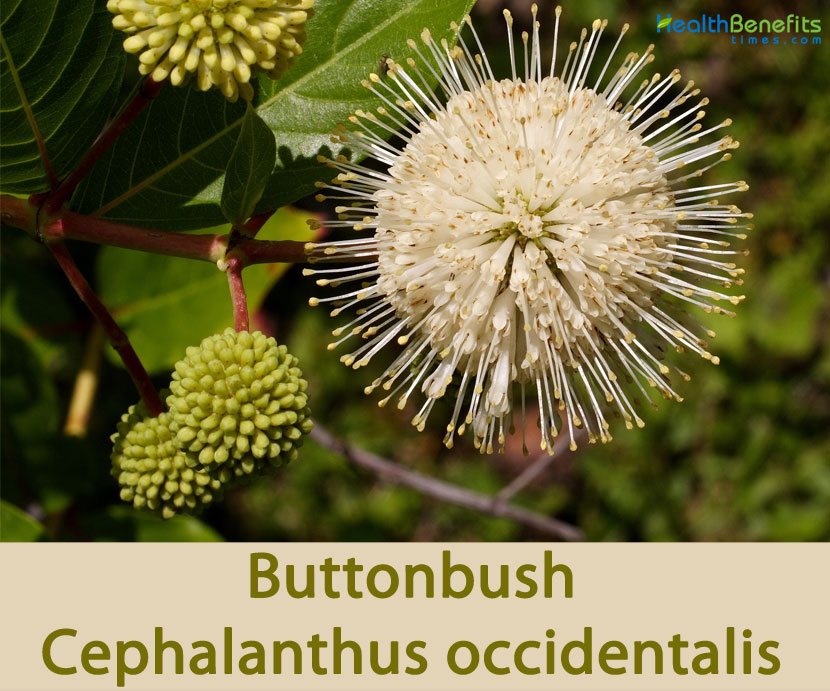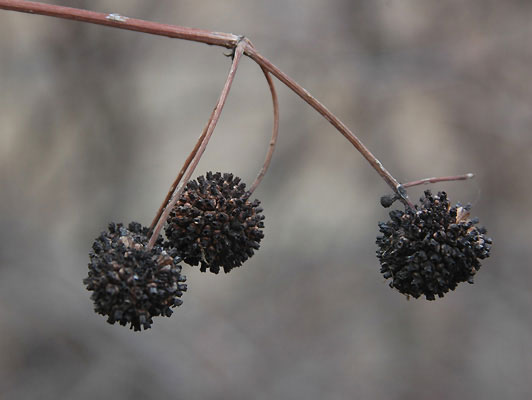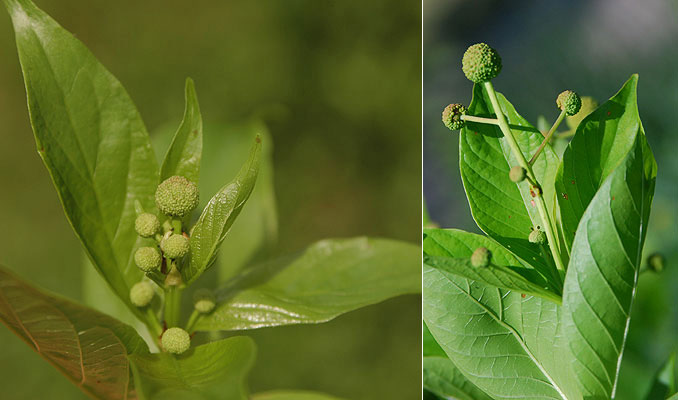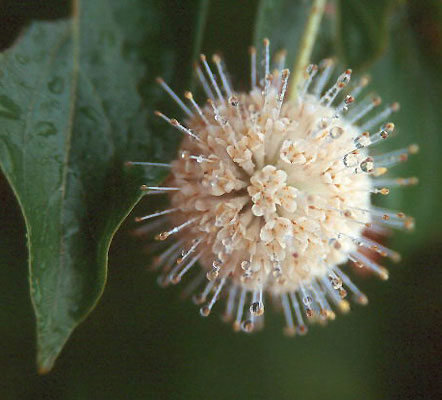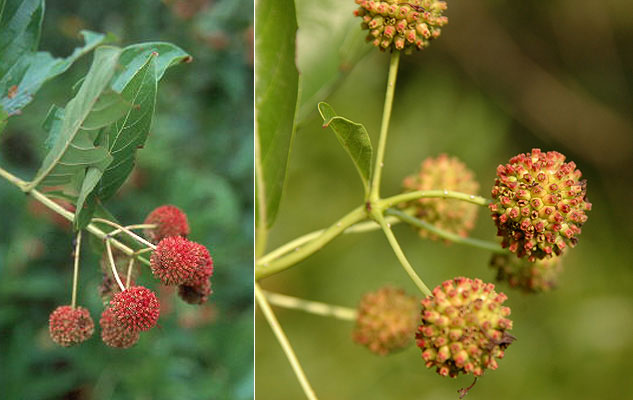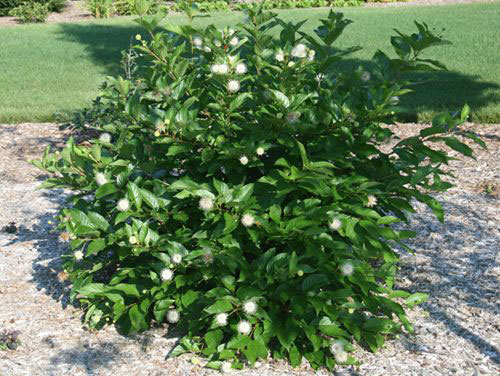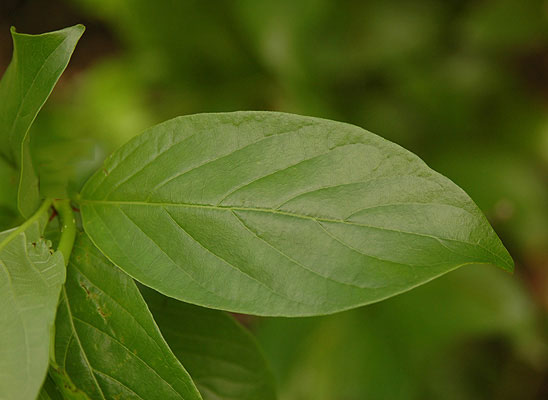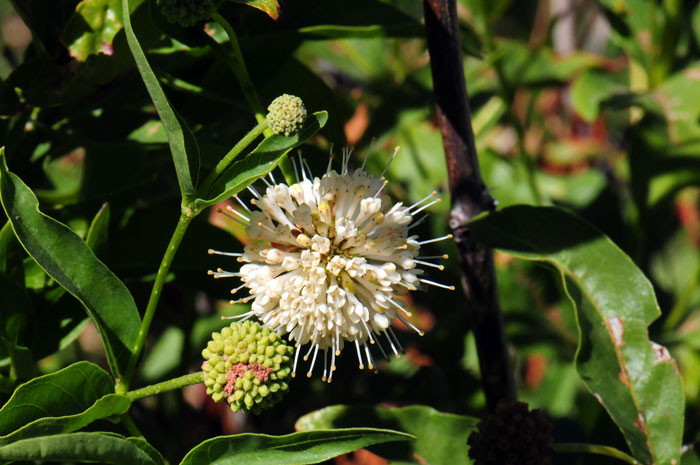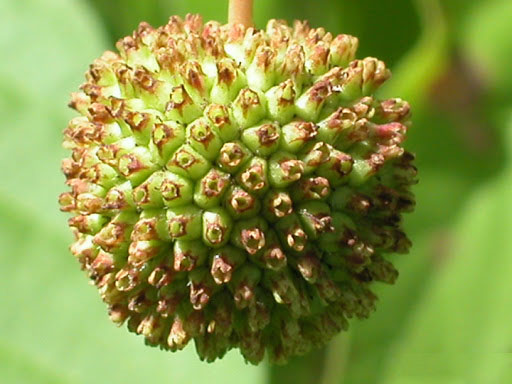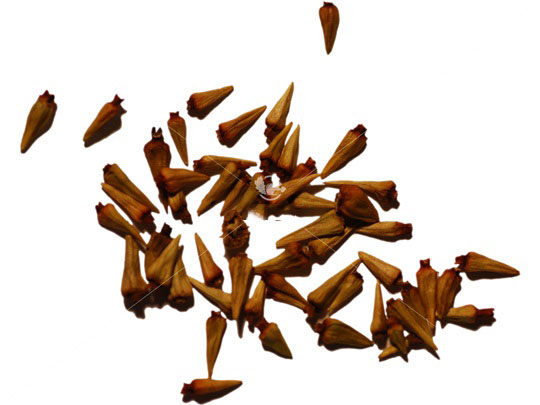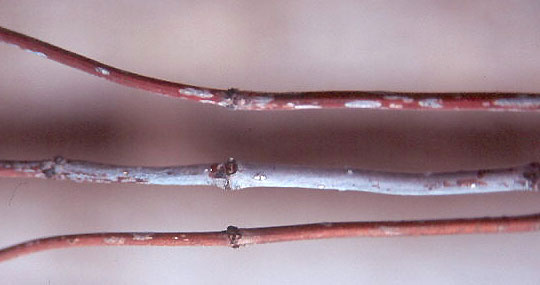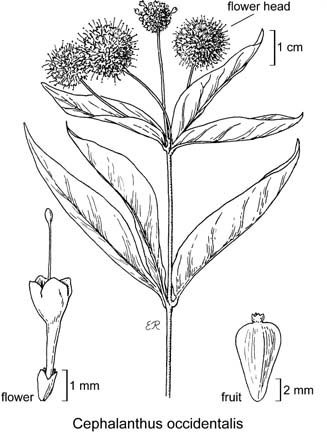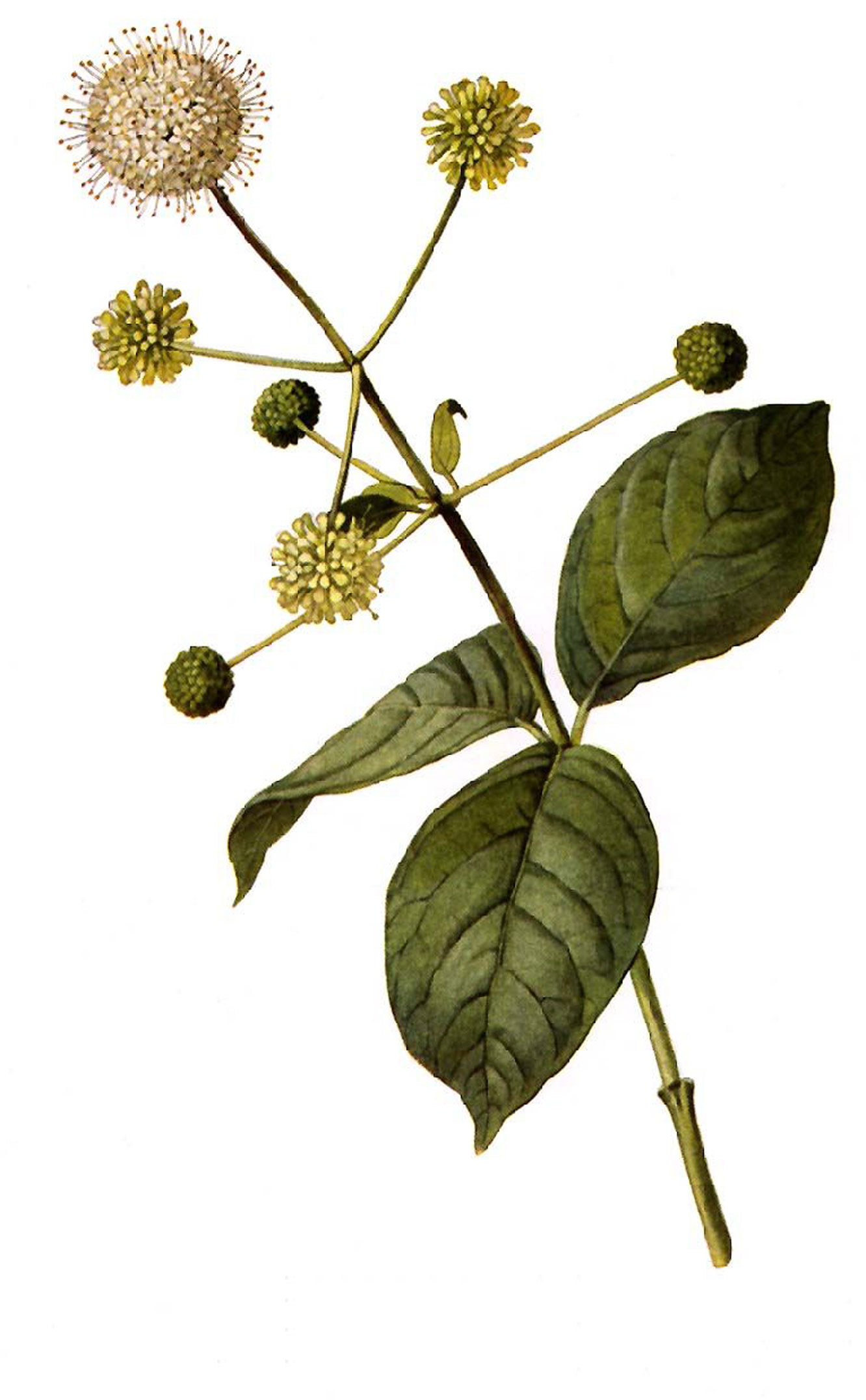Buttonbush Facts
| Buttonbush Quick Facts | |
|---|---|
| Name: | Buttonbush |
| Scientific Name: | Cephalanthus occidentalis |
| Origin | North America |
| Colors | Green turning to reddish to dark reddish-brown with age |
| Shapes | Cone-shaped, 2-sectioned nutlet that is narrowly obpyramidal |
| Taste | Bitter |
| Name | Buttonbush |
|---|---|
| Scientific Name | Cephalanthus occidentalis |
| Native | North America. It occurs from Nova Scotia to Ontario, south through Florida, and west to the eastern Great Plains with scattered populations in New Mexico, Arizona, California, and northern Mexico |
| Common Names | Button Bush, Common buttonbush, Button Willow, Honey Bells, Buttonbush, Button ball, globe-flower, riverbush, Eastern buttonbush, Pincusion flower, buckbrush |
| Name in Other Languages | Czech: Hlavoš západní Danish: Amerikansk Knapbusk Dutch: Gewone kogelboom English: Button-willow, Buttonbush, Common buttonbush, Honey-bells, Eastern buttonbush, Pincusion flower, buckbrush, button-ball French: Céphalanthe occidental, Bois noir, Bois-bouton, Céphalante commun, Céphalante occidental, Cephalanthe americaine, capitule, Germany: Amerikanischer Knopfbusch; Kopfblumenstrauch, Strauchknopfblume Italy: Cefalanto occidentale, capotolo Netherlands: Gewoone kogelboom Polish: Guzikowiec zachodni Russian: Tsvetogolovnik zapadnyy (Цветоголовник западный) Slovak: Hlavoš západný Spanish: Aroma de laguna (Cuba) Swedish: Bollbuske |
| Plant Growth Habit | Deciduous, warm-season, tall wetland shrub or small tree |
| Growing Climates | Openings in floodplain forests, vernal pools in wooded areas, wet thickets, shrubby swamps, wet depressions in black soil prairies, marshes, bogs, ditches, seeps, seasonal wetlands, sloughs, mangrove, pocosin, riparian zones and borders of rivers, streams and small lakes, sinkhole ponds, river bottoms, and low, wet woods |
| Soil | Prefers medium to wet moisture levels. It is intolerant of dry soils. It grows well in sandy, loamy or alluvial soils with sand or silt surfaces. It prefers acidic to neutral soils. It is intolerant of alkalinity. It prefers medium to wet moisture levels and is intolerant of dry soils. It grows more abundantly with increased water and light levels |
| Plant Size | 1–3 m (3.3–9.8 ft.) in height, but can reach 6 m (18 feet) in height at maturity |
| Branches | Branches are usually green when young but turn brown at maturity |
| Twigs | Young twigs are green or reddish in color, 4-sided with elongated lenticels, and turn dark reddish-brown to gray-brown and scaly upon maturation |
| Bark | Thin, gray to brown, later with flattened ridges and deep grooves |
| Leaf | Egg-shaped to oblong-elliptic, 2½ to 6 inches long, 1 to 2¾ inches wide with a sharply pointed tip, and rounded to tapering at the base |
| Flowering season | June through September |
| Flower | Flowers are tubular, 4- to 5-lobed, and white to reddish, 4 cm across, and form in dense clusters at the ends of the branches. Long styles give flowers a pincushion appearance |
| Fruit Shape & Size | Cone-shaped, 2-sectioned nutlet that is narrowly obpyramidal (like a narrow upside-down pyramid). Nutlets are thick-walled and leathery, ¼ to 3/8 inch long |
| Fruit Color | Green turning to reddish to dark reddish-brown with age |
| Seed | Elliptic to cone-shaped, brown with a whitish, fleshy appendage at the tip |
| Propagation | From tip cuttings in the spring or mature wood cuttings in the winter |
| Taste | Bitter |
| Plant Parts Used | Inner Bark, root |
| Season | September and October |
| Precautions |
|
| Other Facts |
|
Plant Description
Buttonbush is a deciduous, warm-season, tall wetland shrub or small tree with an open-rounded habit that normally grows about 1–3 m (3.3–9.8 ft.) in height, but can reach 6 m (18 feet) in height at maturity. The plant is found growing in openings in floodplain forests, vernal pools in wooded areas, wet thickets, shrubby swamps, wet depressions in black soil prairies, marshes, bogs, ditches, seeps, seasonal wetlands, sloughs, mangrove, pocosin, riparian zones and borders of rivers, streams and small lakes, sinkhole ponds, river bottoms, and low, wet woods.
The plant prefers medium to wet moisture levels. It is intolerant of dry soils. It grows well in sandy, loamy or alluvial soils with sand or silt surfaces. It prefers acidic to neutral soils. It is intolerant of alkalinity. It grows more abundantly with increased water and light levels. This plant is easy to grow as long as it’s planted near a stream or water source. It is often used in wetland revegation project in the Central Valley. The root system is branching and woody. Lower stems are up to 4 inches diameter. Main stems are typically multiple from base, often forming colonies from root suckers, and have a rounded but irregular crown. Stem bases are swollen. Branches are usually green when young but turn brown at maturity. Young twigs are green or reddish in color, 4-sided with elongated lenticels, and turn dark reddish-brown to gray-brown and scaly upon maturation. Bark is thin, gray to brown, later with flattened ridges and deep grooves.
Leaves
Leaves are simple and opposite, occasionally whorled in 3s, egg-shaped to oblong-elliptic, 2½ to 6 inches long, 1 to 2¾ inches wide with a sharply pointed tip, and rounded to tapering at the base. The upper surface is hairless, dark green and shiny, the lower surface paler, sometimes with sparse hairs on major veins. Edges are toothless and may be fringed with minute hairs. The leaf stalk is hairless and up to ¾ inch long. At the base of the stalk is a pair of triangular appendages (stipules) about 1/8 inches long. Lateral buds are embedded in the bark and appear as a swelling or small pimple above a leaf scar. In the typical variety of this species, both the young branches and leaves are hairless, although there exists a less common variety of Buttonbush with pubescent branches and leaves.
| Leaf arrangement | Whorled |
| Leaf type | Simple |
| Leaf margin | Entire |
| Leaf shape | Ovate |
| Leaf venation | Pinnate |
| Leaf type and persistence | Deciduous |
| Leaf blade length | 4 to 8 inches |
| Leaf color | Green |
| Fall color | No fall color change |
| Fall characteristic | Not showy |
Flower
Flowers are arranged in a dense spherical flower clusters ¾ to 1 inch in diameter densely packed with 100 to 200 flowers on a short peduncle. Clusters are single at the ends of stalks up to 4 inches long at branch tips and arising from upper leaf axils. Flowers are small white or cream flowers. Each flower has a narrow corolla about 1/3 inches (8 mm.) long, with 4 small spreading lobes at its apex. There are 4 short stamens and a single white style that is quite long and undivided, projecting beyond the corolla. This later characteristic provides the flower head with a starburst appearance. The small green calyx is tubular with 4 small teeth. It is about ¼ inches in length. The blooming period occurs for a long period, from late spring, throughout the summer months, and into early autumn. Flowers are thought to be self-incompatible. The flowers are sweetly fragrant.
| Flower color | white |
| Flower characteristic | pleasant fragrance; spring flowering; summer flowering |
Fruit
Fertile flower heads are replaced by spherical seed heads about ¾ to 1 inch diameter that turn red and eventually dark brown at maturity. Each flower is replaced by a cone-shaped, 2-sectioned nutlet that is narrowly obpyramidal (like a narrow upside-down pyramid). Nutlets are thick-walled and leathery, ¼ to 3/8 inch long. The fruit consists of 2 cells, each cell containing a single seed (occasionally, one of the cells is empty). Seeds are elliptic to cone-shaped, brown with a whitish, fleshy appendage at the tip. Common buttonbush blooms in June through September and sets fruit in September and October. Bonner reported an average of 295,000 seeds/kg. Seeds are high in carbohydrates. Longevity of seeds in storage is unknown but they are thought to be orthodox.
Traditional uses and benefits of Buttonbush
- Button bush was often used medicinally by native North American Indian tribes who used it to treat a range of ailments.
- It is little used in modern herbalism.
- Tea made from the bark is astringent, emetic, febrifuge and tonic.
- Strong decoction has been used to treat diarrhea and dysentery, stomach complaints, hemorrhages etc.
- It has been used as a wash for eye inflammations.
- Decoction of either the roots or the fruits has been used as a laxative to treat constipation.
- Leaves are astringent, diaphoretic, diuretic and tonic.
- Tea has been used to check menstrual flow and to treat fevers, kidney stones, pleurisy etc.
- The plant has a folk reputation for relieving malaria.
- Inner bark has been chewed in the treatment of toothaches.
- Decoctions of the bark were used as washes for sore eyes, antidiarrheal agents, anti-inflammation and rheumatism medications, skin astringents, headache and fever relievers, and venereal disease remedies.
- Roots were used for muscle inflammation and as blood medicines.
- Bark of common buttonbush was traditionally used for making laxatives, and for curing skin, bronchial, and venereal diseases.
- Strong decoction of tree bark is taken as a medicine for dysentery.
- Decoction of roots is taken for hemorrhages.
- Decoction of leaves is taken for rheumatism.
- Decoction of roots taken for menstruation sickness: yellow eyes and skin, weakness and shaking head.
- Bark has been used with much success in intermittent and remittent fevers.
- Inner bark of the root is often employed in coughs.
References:
https://www.itis.gov/servlet/SingleRpt/SingleRpt?search_topic=TSN&search_value=34786#null
https://pfaf.org/user/Plant.aspx?LatinName=Cephalanthus+occidentalis
http://www.missouribotanicalgarden.org/PlantFinder/PlantFinderDetails.aspx?kempercode=g830
https://plants.usda.gov/core/profile?symbol=ceoc2
https://plants.usda.gov/plantguide/pdf/pg_ceoc2.pdf
https://www.fs.fed.us/database/feis/plants/shrub/cepocc/all.html
https://en.wikipedia.org/wiki/Cephalanthus_occidentalis
https://www.cabi.org/isc/datasheet/15734
https://gd.eppo.int/taxon/CPLOC
http://www.theplantlist.org/tpl1.1/record/kew-36721
http://citeseerx.ist.psu.edu/viewdoc/download?rep=rep1&type=pdf&doi=10.1.1.214.892
https://landscapeplants.oregonstate.edu/plants/cephalanthus-occidentalis
https://www.illinoiswildflowers.info/trees/plants/buttonbush.htm


